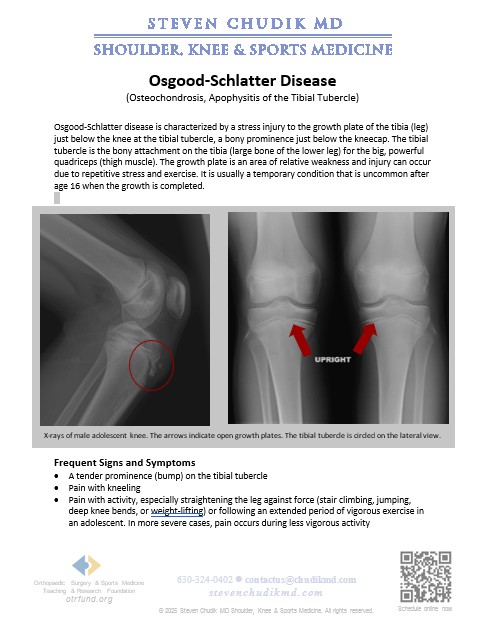Home / Knee Surgeon Chicago Illinois / Knee Injuries and Conditions / Osgood-Schlatter Disease
Osgood-Schlatter Disease (osteochondrosis, apophysitis of the tibial tubercle) is characterized by a stress injury to the growth plate of the leg just below the knee at the tibial tubercle, a prominence just below the kneecap. The tibial tubercle is the bony attachment on the large bone of the lower leg (tibia) for the big, powerful thigh muscle (quadriceps). The growth plate is an area of relative weakness, and injury to it occurs due to repetitive stress from vigorous exercise. It is usually a temporary condition that is uncommon after age 16 or when the growth is completed.
Osgood-Schlatter disease results from repetitive stress and injury to the tibial tubercle growth plate, which is still developing during adolescence. Repetitive stress and injury affects the development of the bony tubercle and causes pain and tenderness to contact.
Initial treatment consists of anti-inflammatory medications (ibuprofen) and ice to relieve pain, stretching exercises, and modification of activities. To control symptoms, kneeling, jumping, squatting, stair climbing, and running on the affected knee should be restricted as necessary to minimize symptoms. An infrapatellar strap, a brace just below the kneecap, may help relieve symptoms. Surgery is occasionally necessary after skeletal maturity if the ossicle (bony fragment) becomes painful. Surgery on adults focuses on removing the painful ossicle and repairing the patellar tendon to relieve symptoms.
Learn More
Content provided by Dr. Chudik not to be used for diagnosis and treatment. You can receive a proper evaluation and diagnosis by making an appointment with Dr. Chudik
 Fate and a torn rotator cuff are changing the lives of countless orthopaedic patients
Fate and a torn rotator cuff are changing the lives of countless orthopaedic patients
Dr Steven Chudik founded OTRF in 2007 to keep people active and healthy through unbiased education and research. Click to learn about OTRF’s free programs, educational opportunities and ways to participate with the nonprofit foundation.
1010 Executive Ct, Suite 250
Westmont, Illinois 60559
Phone: 630-324-0402
Fax: 630-920-2382
(New Patients)
550 W Ogden Ave
Hinsdale, IL 60521
Phone: 630-323-6116
Fax: 630-920-2382
4700 Gilbert Ave, Suite 51
Western Springs, Illinois 60558
Phone: 630-324-0402
Fax: 630-920-2382

© 2025 © 2019 Copyright Steven Chudik MD, All Rights Reserved.
